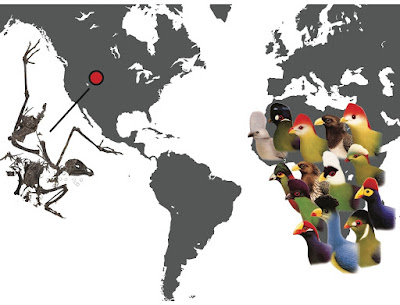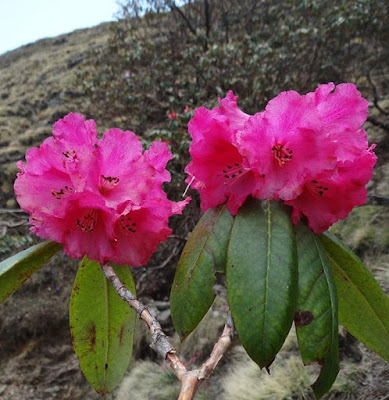[Most Recent Entries] [Calendar View]
Tuesday, June 26th, 2018
| Time | Event | ||||
| 2:17a | [Herpetology • 2018] Oreobates antrum • A New Cryptic Species of Oreobates (Anura: Craugastoridae) from the Seasonally Dry Tropical Forest of central Brazil
Abstract A new species of Oreobates Jiménez de la Espada, 1872 is described from the seasonally dry tropical forest associated to rocky outcrops of the northeastern Goiás State, Central Brazil. Oreobates antrum sp. nov. is diagnosable by the combination of morphological characters (e.g. small size, dorsal and ventral skin texture smooth to finely shagreened, and broadly enlarged truncate discs on Fingers III and IV), call attributes (composed of a single note and no harmonics with dominant frequency ranged 2070 Hz to 3273 Hz), and supported by molecular evidence (phylogenetic position and genetic divergence) with high degree of differentiation among other Oreobates species (divergences of 4.0–20.6% for 12S, 7.0–14% for 16S, 0.7–4.0% for RAG-1, and 1.1–8.0% for TYR). The new species was recovered as the sister of Oreobates remotus. Keywords: Amphibia, Brachycephaloidea; Cerrado biome; Integrative taxonomy; Terrarana
Oreobates antrum sp. nov. Etymology. The specific name antrum is a Latin adjective meaning “hollow, cave or cavity”. This name refers to the habitats where this species is found, caves of the calcareous rocky outcrops of the Cerrado associated to dry forests. Wilian Vaz-Silva, Natan Medeiros Maciel, Sheila Pereira de Andrade and Renata Cecília Amaro. 2018. A New Cryptic Species of Oreobates (Anura: Craugastoridae) from the Seasonally Dry Tropical Forest of central Brazil. Zootaxa. 4441(1); 89–108. DOI: 10.11646/zootaxa.4441.1.5 | ||||
| 10:26a | [PaleoOrnithology • 2018] A North American Stem Turaco, and the Complex Biogeographic History of Modern Birds
Abstract Background: Earth’s lower latitudes boast the majority of extant avian species-level and higher-order diversity, with many deeply diverging clades restricted to vestiges of Gondwana. However, palaeontological analyses reveal that many avian crown clades with restricted extant distributions had stem group relatives in very different parts of the world. Results: Our phylogenetic analyses support the enigmatic fossil bird Foro panarium Olson 1992 from the early Eocene (Wasatchian) of Wyoming as a stem turaco (Neornithes: Pan-Musophagidae), a clade that is presently endemic to sub-Saharan Africa. Our analyses offer the first well-supported evidence for a stem musophagid (and therefore a useful fossil calibration for avian molecular divergence analyses), and reveal surprising new information on the early morphology and biogeography of this clade. Total-clade Musophagidae is identified as a potential participant in dispersal via the recently proposed ‘North American Gateway’ during the Palaeogene, and new biogeographic analyses illustrate the importance of the fossil record in revealing the complex historical biogeography of crown birds across geological timescales. Conclusions: In the Palaeogene, total-clade Musophagidae was distributed well outside the range of crown Musophagidae in the present day. This observation is consistent with similar biogeographic observations for numerous other modern bird clades, illustrating shortcomings of historical biogeographic analyses that do not incorporate information from the avian fossil record. Keywords: Biogeography, Palaeontology, Turaco, Musophagidae, Phylogeny, Fossils, Gondwana, Dispersal, Otidimorphae, Macroevolution Daniel J. Field and Allison Y. Hsiang. 2018. A North American Stem Turaco, and the Complex Biogeographic History of Modern Birds. BMC Evolutionary Biology. 18:102. DOI: 10.1186/s12862-018-1212-3 | ||||
| 2:26p | [Botany • 2012] Rhododendron rawatii (Ericaceae) • A New Species from the Western Himalaya, India
ABSTRACT A new species of Rhododendron, R. rawatii is illustrated and described from the Western Himalaya. The species is sporadically found in the subalpine-timberline zone of Uttarakhand state. Fascicled white cottony hairs on the abaxial surface in between lateral veins of leaves, bright pink and shine-less corolla and comparatively large calyx with hairy margins distinguish the new species from its nearest ally R. fulgens. The populations of the species were found in two geographically distinct localities in the Rudraprayag and Pithoragarh districts of Uttarakhand state. The distinguishing morphological characters, affinities with other species and various ecological aspects of the new species are discussed here. Rhododendron rawatii I. D. Rai & B. S. Adhikari sp. nov. Etymology:— The epithet rawatii acknowledges Prof. Gopal Singh Rawat, one of the leading phytotaxonomists and ecologists of India. Ishwari Datt Rai and Bhupendra S. Adhikari. 2012. Rhododendron rawatii (Ericaceae), A New Species from the Western Himalaya, India. PHYTOTAXA. 71(1):10-16 DOI: 10.11646/phytotaxa.71.1.3 |
| << Previous Day |
2018/06/26 [Calendar] |
Next Day >> |














